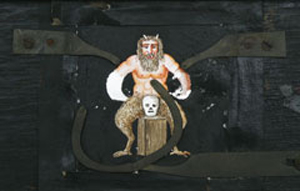This is an archive of the ArtCat Zine, 2007-2009. Please visit our new project, IDIOM.
Ernie Gehr at MoMA

Cotton Candy by Ernie Gehr
MoMA - 11 West 53 Street, New York NY
8pm Friday 1 February and 5:30pm Sunday 3 February 2008
$10
Panoramas of the Moving Image: Mechanical Slides and Dissolving Views from Nineteenth-Century Magic Lantern Shows
12 September 2007 – 10 March 2008
Titus Theater 1 Lobby Gallery, T1
Titus Theater 2 Lobby Gallery, T2
American avant-garde filmmaker Ernie Gehr has been collecting various proto-cinematic devices since the 70s. The MoMA installed several of Gehr's video projections, objects, and a short text on these artifacts in the lobbies to its two Titus theatres last September, in parallel with the filmmaker's extended film retrospective at the MoMA, Ernie Gehr: Moving Image Minimalist. The projections and objects on display — video demonstrations of mechanical glass slide devices, early film "dissolve" prototypes, Zoetrope animation strips, and Phenakistiscope paper discs – were popular in the second half of the 19th century as early media entertainment forms. That Gehr has an interest in these objects and their history in relation to his own métier is consequent both to the work he has been pursuing throughout his career, as well as early cinema's dangerously perishable nature. Gehr here is managing a dual role in their presentation as both a film historian and an artist.
The early Magic Lantern artifacts demonstrated on video and hanging on the walls bear a pronounced historical weight; many of the animated figures on the Zoetrope strips, for example, feature blackface characters engaged in exaggerated movements, carnivalesque imagery of animals and fantasy creatures, a "wild Irishman" and so on — all pictures of the 19th century American "exotic." The historic narratives implied by these crude images, coupled with the austerely ingenious underlying mechanisms which animate the otherwise purely illustrative material, create a sort of hybrid narrative of cinema as a representational tool born out of the industrial revolution, and used, at least in this country, to preserve social conditions rather than aspire to revolutionize them. Seeing the projections especially is an interesting experience as three motion picture (re)presentational methodologies come to a head. The fluid character of digital imaging seamlessly encompasses the mechanical movements of these cine-toys, while the popular museum video presentation tactics of large, multi-channel projections transforms the modest animations into what even the press release unabashedly describes as "a mesmerizing wide-screen spectacle."
This weekend the Museum also hosts its final screenings of the Ernie Gehr film retrospective. The show closes rather appropriately with Cotton Candy, Gehr's first work in digital video completed in 2001. Cotton Candy is an eerie contemplation of a San Francisco mechanical amusement park in disrepair, as Gehr videotapes dejected carousel rides, mutoscope animation toys (a sort of flip book rolodex), and mechanical automatons, all existing lifelessly alongside the menacing presence of a contemporary video arcade where aggressive gameplay in amorphous virtual worlds is rewarded with the further opportunity for image consumption by the arcade's patrons.
ZINE
HOME
TIPS / COMMENTS
CATEGORIES
CONTRIBUTORS
- Greg Afinogenov
- B. Blagojevic
- Adda Birnir
- Susannah Edelbaum
- Julie Fishkin
- Paddy Johnson
- Jessica Loudis
- Christopher Reiger
- Andrew Robinson
- Peter J. Russo
- Blythe Sheldon
- S.C.Squibb
- Hrag Vartanian
